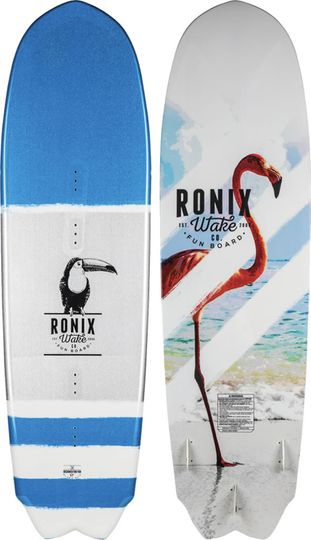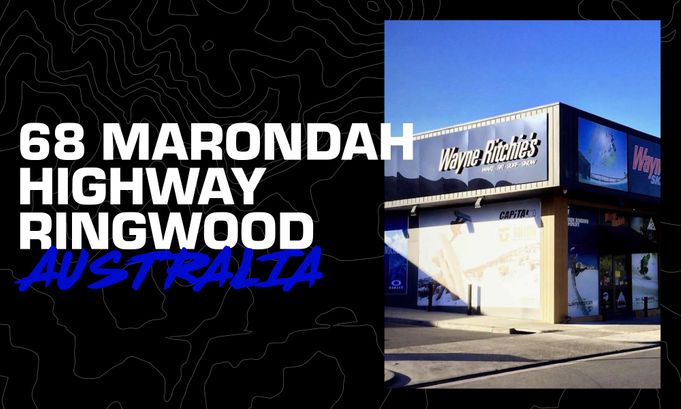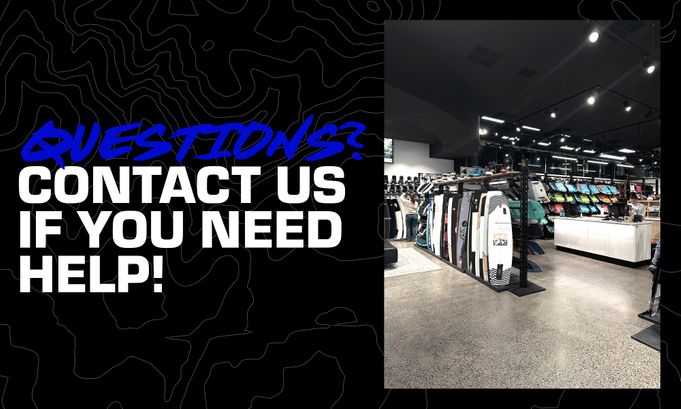Choosing your first wakeboard or upgrading an old board shouldn’t be a daunting task! All wakeboards are designed to suit a specific riding style or ability. In this article we’ll walk you through the important features, shapes, constructions and what makes wakeboards different from one another. We begin by categorising a wakeboard into one of three ability levels: Beginner, intermediate or advanced.
ABILITY LEVELS:
- BEGGINER: A beginner’s wakeboard, as the name implies, is suited to riders new to the sport. Beginner wakeboards will be forgiving, stable and generally easy to ride ultimately assisting rider progression. Beginner wakeboards feature strong channel features and deep, centre-mounted fins [1.75”] which assist straight-line stability. Wakeboarding is one of the only board sports in the world where your shoulders and hips are not always parallel. Your body is crossed up riding toe-side and more inline riding heel-side. Beginner boards take this into consideration with popular models featuring an asymmetrical shape aiding control when on the toe-side.
- INTERMEDIATE: Intermediate wakeboards build on this but dial down certain features to appeal to a wide range of riding styles. Most intermediate wakeboards forego centre fins and adopt dual, outside-mounted fins [0.75” - 1.0”] which assists confident riders allowing them to produce greater edge-hold. Intermediate wakeboards come in a range of shapes and rocker profiles but are mostly universal in their riding style.
- ADVANCED: Advanced wakeboards are designed for riders expanding their trick-bag with flips and spins. Unlike intermediate wakeboards, advanced boards feature specific constructions, shapes, and rocker profiles each tailored to unique riding styles. Riders can choose between a board that has an aggressive riding style with strong edge hold and explosive take-offs, a board that is more relaxed, smooth, and ‘surfy’ or anything between.
PROFILES:
- CONTINIOUS ROCKER: Down to the nitty gritty! The profile of a wakeboard drastically changes its personality and riding style. The profile of a wakeboard is defined as the boards shape when viewed on its side from tip to tail. A ‘continuous’ rocker wakeboard features a smooth, consistent arc with no flat spot interruptions. Continuous rocker wakeboards carry more top-water speed, feature smooth, consistent take-offs and softer landings. While a continuous rocker board may not have as much ‘pop’ as its 3-stage rival, it is more likely to carry you further out into the flats. Continuous rocker boards are easier on the body but also a popular option behind large boat wakes where a lack of pop is not a concern.
- 3-STAGE ROCKER: Continuous rockers arch nemesis, ‘3-Stage’ rockers feature a flat spot between the bindings. This flat spot interrupts the flow of water but instead creates a solid platform for the wakeboard to ‘pop’ off when releasing from the top of a wake. 3-stage wakeboards often feel ‘loser’ on the water and may not carry as much top-water speed as continuous boards, however they are more likely to give more punch and go higher off a wake.
CONSTRUCTIONS:
- Wakeboard constructions have changed significantly over the years with the introduction of high-end performance foam and carbon fibre laminates. All beginner wakeboards feature a traditional PU (polyurethane) foam core and standard fibreglass laminates holding it all together! This construction is tough, durable, forgiving and relatively inexpensive.
- In the early 2000’s high performance foams such as polyvinyl chloride [PVC] were introduced into advanced wakeboards. PVC foam cores are more responsive and lightweight resulting in a wakeboard that feels more ‘explosive’. More recently, various other technologies such as carbon fibre laminates or stringers have been added further improving strength and performance.
SIZE GUIDE:
Choosing the correct size of wakeboard depends on your weight and the style of board however wakeboarder preferences can be considered with most wakeboards are available 3 or 4 size increments. Large boards provide more surface area and buoyancy however become slightly heavier and bulkier underfoot. If you are purchasing a wakeboard to be shared amongst a group, it is important that the largest rider’s weight be accounted for. Personal preference may be considered when choose a wakeboard size; It is likely that a rider may choose to size-up as a larger board with more surface area will aid deep water starts, increase stability, and reduce drag.
- 120 cm (Up to 40 kg)
- 125 cm (40 - 50 kg)
- 130 cm (50 - 60 kg)
- 135 cm (60 - 70 kg)
- 140 cm (70 - 85 kg)
- 145 cm (85 - 100 kg)
- 150+ cm (90+ kg)
Ronix 2019 FUN BOARD
- Online
- Ringwood Store
Description
TAKE YOUR RIDING BACK TO ITS DIRECTIONAL ROOTS
It has been nearly 50 years that our family has been designing watersports products - one of the things we have learned is sometimes rider’s just want something fun and simple. A chance to carry year-round the sensation you get on those brisk winter mornings on a mountain engaging in a session of high speed whips on a wide open groomer. So we came up with the concept of the Fun Board with 5 main goals to achieve…
Specifications
• Our most stable platform
• Equally mixes the design and feeling of your favorite snowboard, wakeboard and surfboard
• A board for the path on the water - more than the flight in the air.
• Best ridden behind your 15 year old jet ski as much as a modern day wake boat.
• Increase your carve count, and carry on with a longer riding session.
Shipping ETA
| DESTINATION | Small Items < 1kg | Large Items |
| Melbourne Metro | 1 Business Day | 1 Business Day |
| Victoria | 1-3 Business Days | 1-3 Business Days |
| New South Wales | 1-3 Business Days | 1-3 Business Days |
| Queensland | 1-3 Business Days | 1-3 Business Days |
| South Australia | 1-3 Business Days | 1-3 Business Days |
| Tasmania | 2-5 Business Days | 2-5 Business Days |
| Western Australia | 2-5 Business Days | 2-5 Business Days |
| Northern Territory | 3-7 Business Days | 3-7 Business Days |
Warranty
Products sold by Wayne Ritchie's come with consumer guarantees and a minimum manufacturer warranty of 12 months. A manufacturers warranty covers defects that occur during the manufacturing process that result in the product having poor performance or being unfit for use. The manufacturers' warranty does not cover misuse or accidental damage. Minor faults such as delaminations, broken clips, ratchets, laces and tube inners or other replaceable parts will be repaired in a reasonable time frame. Serious faults that hinder use and cannot be repaired such as cracks and tears will be replaced, or a store credit issued for the same value. In the event of a defect, please visit Wayne Ritchies in-store, or submit via the online form. Purchase history must be provided for all claims so please submit your original purchase receipt or invoice. In some cases, a bank statement showing the original purchase date is applicable.
Shipping & Returns
SHIPPING POLICY
Large items over 1 metre cannot be shipped to PO Boxes or Parcel Lockers. Large items are shipped by courier so please provide us with a business or street address where someone will be present at the delivery address between 9am-5pm to sign for the delivery. If you are not present when delivery is attempted we cannot guarantee it will be re-delivered in a timely manner. It may be returned to us or allocated to a third party company which we have no control over, and a re-delivery fee may be incurred in some instances. Once your order has been shipped you will be provided with a tracking number to follow the progress of your order online. It is the full responsibility of the receiver to ensure someone is present at the specified delivery address as there will be no compensation by Wayne Ritchie's for lost or missing parcels. All deliveries notated with "leave at front door" or similar will be left at the buyer's risk, no responsibility will be taken by Wayne Ritchie's for lost or missing parcels.
Incorrect addresses: In the event that you enter an incorrect or invalid address causing your order to be returned to us, a $20 fee will be charged before we can re-send the order to you a second time.
Pick-up in-store: Your click and collect order will typically be ready with 4 hours of placing your online order (during business hours) but this timeframe may differ on weekends and during late night trade periods. PLEASE DO NOT arrive to collect your order until you have received a pick-up confirmation email.
Pre-order items: we cannot provide guaranteed shipping dates but pre-orders are given priority and will be shipped immediately the same day the goods arrive in our warehouse.
We endeavour to keep our extensive online range as up-to-date as possible but if you cannot find what you're looking for, please Contact Us and we will do our best to find it for you.
RETURNS POLICY
Wayne Ritchie's Skiers Edge offers free returns for items that are faulty, not as described or incorrect item shipped. Please return the item to us within 14 days of date of purchase and will will issue a refund or replacement. If you change your mind, an item does not fit or the wrong size is ordered it can be returned to us in the brand new condition you received it and we will happily exchange it or issue a refund. PLEASE NOTE: it is the buyer's responsibility to pay return shipping on change of mind, items that do not fit or have been incorrectly ordered.
*Conditions Apply.
PLEASE NOTE:
- Sale items are offered at significantly discounted prices so please choose carefully as we WILL NOT accept exchanges or returns on sale items.
- Wayne Ritchie's reserves the right to cancel any online order without notice.
- It is the responsibility of the customer to adhere to our terms and conditions as stated above.
- To view our full terms and conidtions Click Here
Visit Us in Store
Experience the largest Australian water sports and snow sports pro-shop in-store! We welcome our customers to enjoy the most immersive range of skis, boards and accessories.
Shipping ETA & Returns
Enjoy free express shipping on all orders over $100, or just $12.95 express shipping on all orders under $100. We'll dispatch orders on the same day if ordered before 12pm.
Get in Touch
We're here to help! If you've got a question regarding our products or services, click below for our phone and email contact details or send us a message via Facebook Messager.
About Us
Wayne Ritchie's is a specialty watersports and snowsports retailer, family owned and operated since 1986. We pride ourselves on an unrivalled customer experience.







